ॐ श्री गुरुभ्यो नमः ॐ श्री शिवानन्दाय नमः ॐ श्री चिदानन्दाय नमः ॐ श्री दुर्गायै नमः
Source of all Images in this Blog-post : Google Images : ‘Google Image Search’ will reveal the multiple sources of every single image shared in this Blog. For more details, kindly see ‘Disclaimer‘
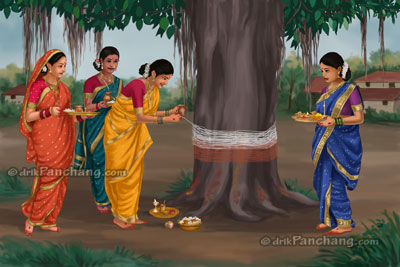
Vat Purnima (वट पूर्णिमा, Vaṭapūrṇimā, also called Vat Savitri is a Hindu celebration observed by married women in Mithila and in the Western Indian states of Maharashtra, Goa, Gujarat and some regions of Uttar Pradesh.
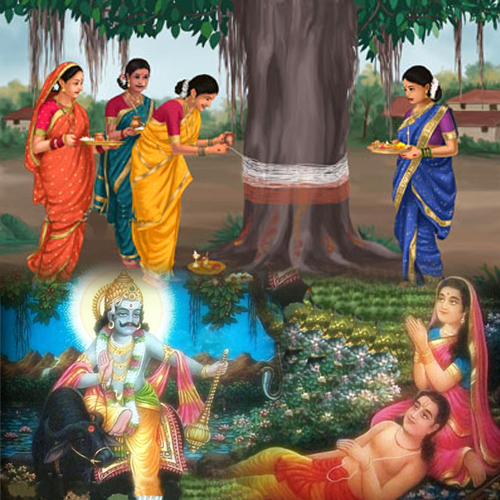
On this Purnima (full moon) during the three days of the month of Jyeshtha in the Hindu calendar (which falls in May–June in the Gregorian calendar) a married woman marks her love for her husband by tying a ceremonial thread around a banyan tree.
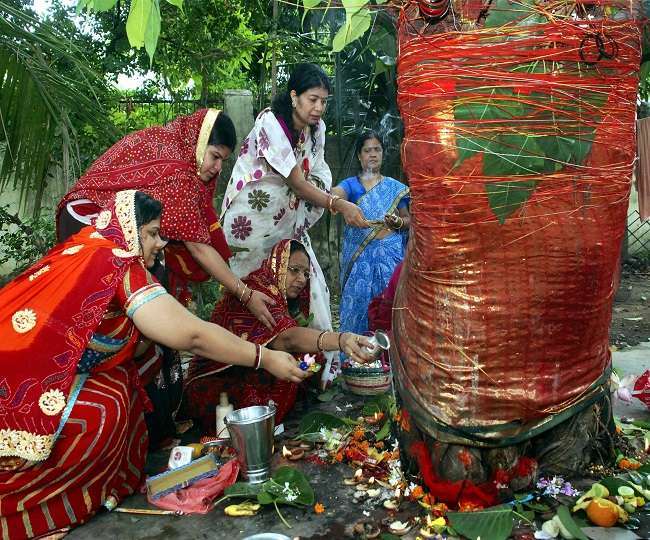
The celebration is based on the legend of Savitri and Satyavan as narrated in the epic Mahabharata.
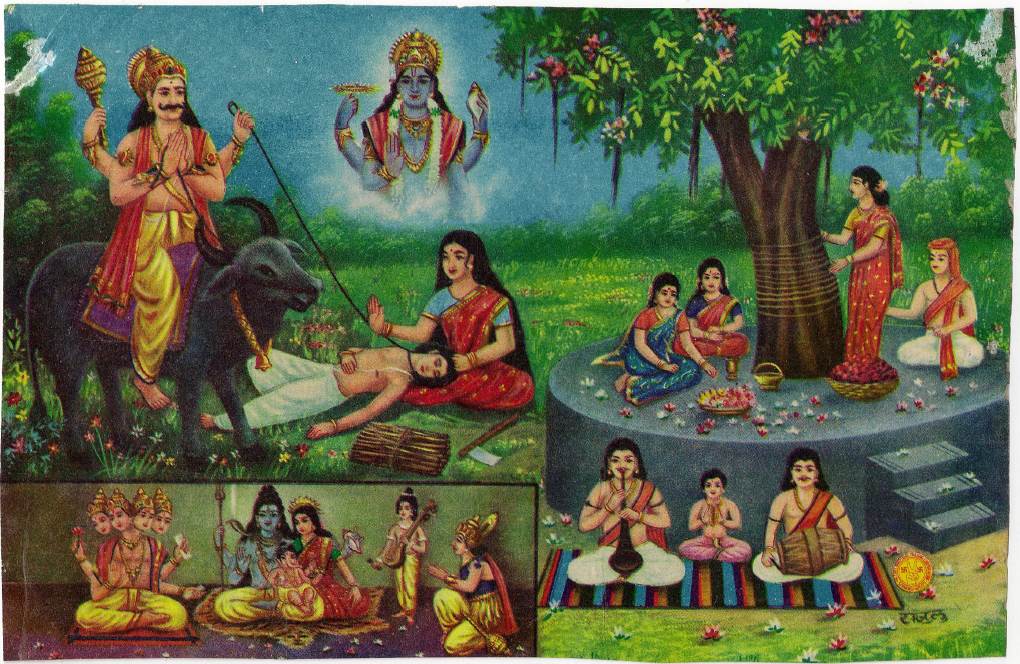
History :
The legends dates back to a story in the age of Mahabharata. The childless king Asvapati and his consort Malavi wish to have a son. Finally, the God Savitr appears and tells him he will soon have a daughter.
The king is overjoyed at the prospect of a child. She is born and named Savitri in honor of the god. Method of Vat Purnima Vrata in Skanda Purana, which is the 14th of Puranas.
She is so beautiful and pure, and intimidates all the men in her village that no man will ask for her hand in marriage. Her father tells her to find a husband on her own.
She sets out on a pilgrimage for this purpose and finds Satyavan, the son of a blind king named Dyumatsena who lives in exile as a forest-dweller.
Savitri returns to find her father speaking with Sage Narada who tells her she has made a bad choice; although perfect in every way, Satyavan is destined to die one year from that day. Savitri insists on going ahead and marries Satyavan.
Three days before the foreseen death of Satyavan, Savitri takes a vow of fasting and vigil. Her father-in-law tells her she has taken on too harsh a regimen. But she replies that she has taken an oath to perform the regimen and Dyumatsena offers his support.
The morning of Satyavan’s predicted death, he is splitting wood and suddenly becomes weak and lays his head in Savitri’s lap and dies. Savitri places his body under the shade of a Vat (Banyan) tree.
Yama, the god of Death, comes to claim Satyavan’s soul. Savitri follows him as he carries the soul away. She offers him praise, and Yama impressed by both the content and style of her words, offers her any boon, except the life of Satyavan.
She first asks for eyesight and restoration of the kingdom for her father-in-law, then a hundred children for her father, and then a hundred children for herself and Satyavan.
The last wish creates a dilemma for Yama, as it would indirectly grant the life of Satyavan.
However, impressed by Savitri’s dedication and purity, he offers her one more chance to choose any boon, but this time omitting “except for the life of Satyavan”.
Savitri instantly asks for Satyavan to return to life. Yama grants life to Satyavan and blesses Savitri’s life with eternal happiness.
Satyavan awakens as though he has been in a deep sleep and returns to his parents along with his wife. Meanwhile, at their home, Dyumatsena regains his eyesight before Savitri and Satyavan return.
Since Satyavan still does not know what happened, Savitri relays the story to her parents-in-law, husband, and the gathered ascetics.
As they praise her, Dyumatsena’s ministers arrive with news of the death of his usurper. Joyfully, the king and his entourage return to his kingdom.
Though the tree does not play a significant role of the story, it is worshiped in memory of the love in the legend. The festival is followed by married women only, and is prohibited for children and widows.
Festival :
Vat Purnima in English means a full moon related to the banyan tree. It is a Hindu festival celebrated strictly in the Northern and Western Indian states Maharashtra, Goa, Gujarat .
The period of the festival is observed over three days, usually the 13th, 14th and 15th days in the month of Jyestha (May–June). Women observe a fast and tie threads around a banyan tree and pray for the well-being of their husbands.
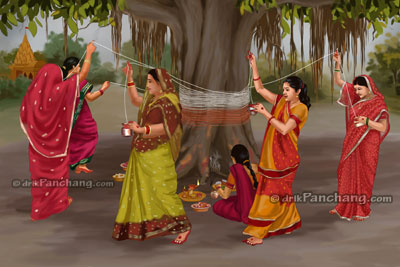
Fast and Tradition :
On the occasion of Vat Purnima, women keep a fast of three days for their husbands, as Savitri did. During the three days, pictures of a Vat (banyan) tree, Savitri, Satyavan, and Yama, are drawn with a paste of sandal and rice on the floor or a wall in the home.
The golden engravings of the couple are placed in a tray of sand, and worshiped with mantras (chanting), and Vat leaves.
Outdoors, the banyan tree is worshiped. A thread is wound around the trunk of the tree, and copper coins are offered. Strict adherence to the fast and tradition is believed to ensure the husband a long and prosperous life.
During the fast, women greet each other with ‘जन्म सावित्री हो’ (English: Become a Savitri). It is believed that until the next seven births their husband will live well.
In the present day, the festival is celebrated in the following way. Women dress in fine Sarees and jewelry, and their day begins with the offering of any five fruits and a coconut.
Each woman winds white thread around a banyan tree seven times as a reminder of their husbands. They fast for the whole day.
Vat-Pournima: Worship of the banyan tree :
Tree worship is an integral part of Indian culture. Right from the days of the Indus valley civilization, there are references to tree worship. The Vat-Pournima which is celebrated on the full moon day of the Jyeshta, symbolizes the worship of the banyan tree.
Jyeshta is the third month of the Hindu calendar.
There is a mythological story associated with the ceremony of Vat-Pournima. This tells us that Savitri, by worshipping the banyan tree on the Jyeshta Pournima, brought back to life her dead husband by the grace of Yama, the god of death.
In Goa, Hindu married women observe a whole day of fasting and perform Pooja of the banyan tree, urging the tree to grant a long, healthy and happy life to their husbands.
The banyan tree has the ability to support its ever growing branches by the development of adventitious roots from its branches. These roots, which hang down and act as props over an ever widening circle, represent eternal life and are regarded as a symbol of a long life.
The banyan tree is considered as sacred by various tribal communities as well. As Gautam Buddha sat under this tree for seven days, it is regarded as holy by the Buddhists too.
The first Tirthankara of Jainism, Rishabhanath received perfect knowledge under the banyan tree. Thus, the tree is sacred to the Jains as well.
The leaves of the banyan tree are used as fodder for elephants and for making leaf-plates. The fruits are eaten by birds, monkeys and bats. The aerial roots are used to make tent-poles and cart-yokes.
Different parts of the banyan tree have been used as medicine for the treatment of several ailments.
The Goan culture has given importance to the banyan tree and throughout Goa there are many huge banyan trees. The banyan tree at Parce-Pernem spell binds you due to its height, whereas the giant banyan tree of Partagal Canacona is a charming creation of nature’s phyto architectural skills.
In the name of folk deities like Rashtroli, Vathari, Mharingan, Brahman and others, these trees are considered as very holy, and are worshipped and thus protected.
By protecting a banyan tree, we can get cool shade and it helps by providing a large quantity of oxygen as well.
In city areas, Hindu women go to the market and fetch a twig as an alternative for a tree. This is a false practice. Planting a banyan tree in the locality and worshipping it is the need of the hour.
As this festival comes in the monsoon season, during the rains women enjoy the fresh and cool atmosphere under the banyan tree. Besides, in the leaf-cup, women distribute prasad consisting of pieces of different juicy fruits.
